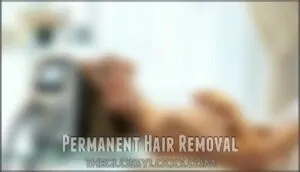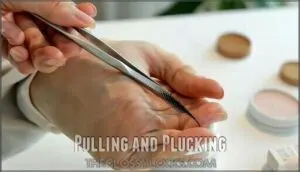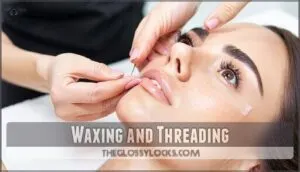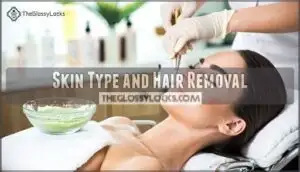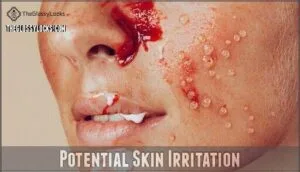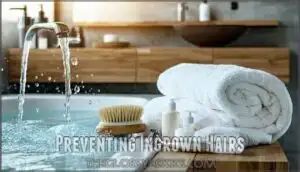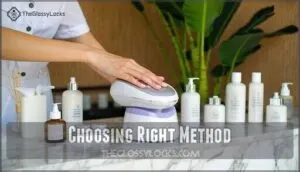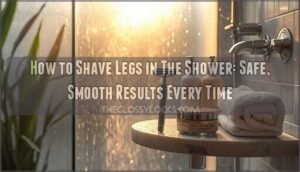This site is supported by our readers. We may earn a commission, at no cost to you, if you purchase through links.
 You’ll find safe hair removal techniques that match your skin’s needs without the drama of razor burn or ingrown hairs.
You’ll find safe hair removal techniques that match your skin’s needs without the drama of razor burn or ingrown hairs.
For sensitive skin, try sugaring or threading since they’re gentler than traditional waxing. Oily skin handles laser treatments and epilators well because they’re less prone to irritation.
Always prep your skin with exfoliation and use proper aftercare to avoid bumps. Shaving works for quick fixes, but waxing lasts longer if you can handle the temporary sting.
Each method has its sweet spot depending on your pain tolerance and time commitment. The secret lies in understanding which technique will become your skin’s best friend.
Table Of Contents
- Key Takeaways
- Temporary Hair Removal
- Permanent Hair Removal
- Hair Removal Techniques
- Safe Removal Considerations
- Choosing Right Method
- Frequently Asked Questions (FAQs)
- What is the safest way to remove hair down there?
- What’s the healthiest way to remove body hair?
- What do the Kardashians use for hair removal?
- What is the safest permanent hair removal?
- What age is safe to start hair removal?
- How to treat razor burns and cuts?
- Which medications affect hair removal effectiveness?
- Are there hair removal allergies to consider?
- Conclusion
Key Takeaways
- Match your method to your skin type – sensitive skin needs gentler options, like sugaring or threading, while oily skin handles laser treatments and epilators better without irritation.
- Always prep and follow proper aftercare – exfoliate before hair removal and moisturize afterward to prevent razor burn, ingrown hairs, and skin irritation.
- Consider your long-term goals – choose temporary methods, like shaving, for quick fixes or permanent solutions, like electrolysis and laser removal, for lasting results.
- Test before committing – patch-test chemical depilatories and start with small areas to avoid allergic reactions and find what works best for your unique skin.
Temporary Hair Removal
When you’re looking for a quick fix to unwanted hair, temporary methods offer flexible solutions that fit your lifestyle and budget.
These techniques range from the simple convenience of shaving to the longer-lasting results of waxing, each with distinct benefits for different situations.
Shaving Methods
Two million people shave daily, yet many skip essential safety steps. Proper shaving methods protect your skin while delivering smooth results every time.
Here are 5 essential shaving safety tips:
- Prep with warm water – Soften hair texture and open pores before applying shave creams
- Choose quality razors – Sharp blades prevent razor burn and reduce nicks
- Shave with the grain – Follow hair growth direction to minimize irritation
- Replace blades regularly – Dull blades cause tugging and increase infection risk
- Moisturize afterward – Hydrate skin to prevent dryness and ingrown hairs
Regular blade maintenance keeps your shaving routine safe and effective. Understanding shaving techniques is vital for achieving smooth skin.
Tweezing Techniques
While shaving handles surface hair quickly, tweezing targets individual hairs at the root for longer-lasting results.
Master proper tweezer safety by sterilizing tools and pulling hair in the growth direction to prevent breakage. Using the right tweezers for hair is essential for effective hair removal.
| Technique | Best For |
|---|---|
| Slanted tweezers | Eyebrow shaping, coarse hairs |
| Pointed tweezers | Fine hairs, ingrown removal |
| Flat tweezers | Splinter removal, stubborn hairs |
| Illuminated tweezers | Precision work, poor lighting |
Quality follicle care means plucking one hair at a time with steady pressure to avoid skin damage.
Chemical Depilation
Chemical depilatories offer a painless alternative when tweezing feels too tedious.
These hair removal creams dissolve keratin bonds, weakening hair until it falls out within days.
You’ll get smooth results lasting up to a week, but chemical sensitivity can cause reactions.
- Depilatory creams work faster than waiting for tweezed hair to regrow
- Chemical peels in these products can irritate sensitive skin types
- Hair dissolvers require patch testing before full application
- Skin exfoliants in formulas may cause redness or burning
- Keratin treatments break down hair structure at surface level
Waxing Benefits
Beyond the initial sting, waxing advantages include smooth skin that lasts three to six weeks.
Professional waxing techniques deliver superior hair reduction compared to shaving.
The exfoliation benefits remove dead skin cells alongside unwanted hair, and body sugaring and traditional hair removal waxing methods weaken follicles over time, creating finer regrowth.
You’ll enjoy long lasting results that make the temporary discomfort worthwhile.
Permanent Hair Removal
When you’re ready to stop the constant cycle of hair removal, permanent methods offer a lasting solution.
Electrolysis and laser hair removal target hair follicles directly, giving you smooth skin that doesn’t require weekly maintenance.
Electrolysis Process
Electrolysis uses radio frequency currents delivered through fine needles to destroy each hair follicle permanently.
This FDA-approved permanent hair removal method works on all hair colors and skin types, achieving over 90% success rates.
The electrolysis treatment process targets individual follicles, making it the gold standard for permanent results when you want complete hair removal.
The process may require multiple sessions, but it offers truly permanent hair removal.
Laser Hair Removal
Laser hair removal uses concentrated light beams to target hair follicles, offering lasting results beyond electrolysis. This FDA-approved method requires multiple sessions but delivers impressive outcomes.
Here’s what makes laser treatment appealing:
- 74% of patients achieve 75-100% hair clearance after just three treatments
- 10-25% reduction happens after your first session – you’ll see results quickly
- Long-term improvement lasts 11.5 years for most people
- Modern lasers work safely on darker skin tones using advanced technology
- Hair regrows finer and lighter when it does return
Laser safety depends on professional training and proper equipment calibration. Treatment costs range from $50-$900 per session, with small areas like upper lips being most affordable. Hair removal safety improves with experienced technicians who understand skin reactions and removal efficacy.
While permanent hair removal isn’t guaranteed, IPL hair reduction offers excellent long-term results for most hair removal techniques. For the best results, it’s necessary to research laser hair removal procedures thoroughly before undergoing treatment.
Hair Follicle Destruction
Understanding how follicle removal works can help you choose the right permanent hair reduction method.
Both electrolysis and laser treatment target hair follicles differently.
The electrolysis process uses electrical current to destroy each follicle individually, while laser hair removal and IPL hair reduction use light energy for hair destruction.
These methods achieve permanent reduction by damaging the follicle’s ability to produce new hair strands, resulting in permanent reduction.
Hair Removal Techniques
You’ve got several proven techniques to choose from when removing unwanted hair safely and effectively.
Each method works differently on your skin and hair, so understanding the basics helps you pick what’s right for your body and lifestyle.
Pulling and Plucking
Pulling and plucking offer precision for small areas like eyebrows and facial hair.
When tweezing, you’re removing the entire hair follicle, which means results last several weeks.
These epilation methods work best on coarse, dark hairs.
Always pull in the direction of hair growth to prevent breakage.
Clean tweezers before use and stretch skin taut for easier removal, using tweezers.
Waxing and Threading
Waxing and threading offer precision that plucking can’t match for larger areas.
Waxing tips include proper skin preparation—clean, dry skin works best. Threading tools require steady hands but excel on sensitive skin prone to breakouts.
Both hair removal techniques last 4-6 weeks. Aftercare techniques matter: apply soothing aloe and avoid tight clothing immediately after these safe hair removal methods.
Epilator Devices
Epilator devices mechanically pluck multiple hairs from the root, delivering smooth skin for 2-4 weeks.
These handheld tools offer epilator benefits like convenience and cost-effectiveness over time. However, epilation can cause initial discomfort and potential ingrown hairs.
For device safety, clean your epilator after each use and replace heads regularly. Following proper epilation tips guarantees optimal hair removal results.
When choosing an epilator, consider epilator device options to find the best fit for your needs.
Sugaring Methods
Sugar waxing offers a gentler alternative using natural ingredients like sugar, lemon, and water.
You can create homemade sugaring paste or buy commercial versions.
Natural sugaring works well for facial sugaring and body sugaring, pulling hair in the growth direction to reduce breakage.
This ancient hair removal method suits sensitive skin better than traditional wax, making it perfect for those seeking natural hair removal solutions, and is a great option for gentler alternative hair removal.
Safe Removal Considerations
Before you start any hair removal routine, you’ll want to know your skin type and choose methods that won’t leave you looking like a angry lobster.
Your hair growth patterns and skin sensitivity determine which techniques will work best for you without causing irritation or those pesky ingrown hairs that nobody wants to deal with.
Skin Type and Hair Removal
Your skin type dramatically affects which hair removal methods work best.
Your skin’s unique characteristics determine which hair removal technique will give you the smoothest results without unwanted drama.
Sensitive skin responds well to threading and hard waxes, while oily skin benefits from waxing’s deep cleansing action.
Dry skin needs moisturizing depilatory creams or laser treatments to avoid irritation.
Combination skin requires targeted approaches for different areas.
Understanding proper waxing techniques using professional waxing kits is essential for effective hair removal.
Hair Growth and Removal
Understanding your natural hair growth patterns helps you choose the best removal methods for lasting results.
Body hair completes its cycle in about one month, while factors like genetics and nutrition affect growth speed.
- Hair Texture varies by body area – coarse leg hair needs different tools than fine facial hair
- Follicle Health determines how well temporary hair removal methods work long-term
- Growth Patterns show when hair’s most vulnerable to removal techniques
- Removal Tools should match your specific hair type and skin conditions for safe results
Potential Skin Irritation
Hair removal can feel like walking through a minefield for your skin. Even gentle methods can trigger unexpected reactions, leaving you with angry red bumps instead of smooth results.
Understanding proper shaving techniques is essential to minimize skin irritation and achieve better outcomes.
| Method | Common Skin Reactions | Risk Level |
|---|---|---|
| Shaving | Razor burn, redness, bumps | Medium |
| Waxing | Peeling, scabbing, soreness | High |
| Depilatory creams | Burning, stinging, erythema | High |
| Laser removal | Swelling, itching, redness | Medium |
Skin sensitivity varies dramatically between individuals. Sensitive skin types face higher risks of irritation causes like burning sensations and prolonged redness.
Chemical depilatories containing calcium hydroxide can trigger severe reactions. Aftercare tips include applying cool compresses and avoiding sun exposure immediately after treatment to prevent complications.
Preventing Ingrown Hairs
Beyond skin irritation lies another common concern that can turn your smooth results into bumpy disappointments.
Ingrown hairs develop when hair follicles become trapped beneath the skin’s surface, creating painful bumps that nobody wants.
Here are three key aftercare methods to prevent ingrown hairs:
- Gentle exfoliation tips: Use a soft brush or mild scrub 2-3 times weekly to remove dead skin cells that block hair follicles from emerging properly.
- Proper skin care routine: Apply alcohol-free moisturizer daily and avoid tight clothing immediately after tweezing or other hair removal techniques.
- Smart technique adjustments: Pull hair in the direction of growth and avoid aggressive razor bumps by using sharp, clean tools every time.
Choosing Right Method
With so many hair removal options available, you’ll want to match your method to your skin type, hair texture, and lifestyle needs.
Consider factors like pain tolerance, budget, and whether you’re seeking temporary convenience or permanent results to make the best choice for your situation, taking into account your lifestyle needs.
Benefits of Each Method
Each hair removal method offers distinct skin benefits and longevity factors.
Shaving provides quick results without pain, while waxing delivers three to six weeks of smoothness.
Laser hair removal creates permanent hair reduction after multiple sessions.
Sugaring uses natural ingredients that’re gentler on sensitive skin, and threading offers precise control for facial areas.
Electrolysis achieves permanent results for all hair types, and understanding hair removal methods is essential for making informed decisions about one’s hair removal routine.
Drawbacks of Each Method
While each method offers benefits, you’ll encounter specific hair removal drawbacks that deserve consideration.
Shaving causes skin irritation and ingrown hairs within days, while tweezing brings pain factors and potential scarring risks.
Chemical depilatories can trigger severe reactions, and waxing creates regrowth issues lasting weeks.
Even permanent methods like laser and electrolysis carry hair removal side effects including burns and discoloration complications.
Considering Skin and Hair
Your skin type and hair texture work together like dance partners—what suits one person might irritate another.
Sensitive skin needs gentler hair removal methods, while coarse hair requires stronger approaches.
Check your skin’s reaction history and hair follicle density before choosing.
Fine hair responds well to lasers, but thick hair might need electrolysis for effective damage prevention and healthy regrowth patterns.
Long-Term Hair Removal Goals
When planning your hair removal journey, think beyond quick fixes and consider what you’ll want your skin to look like years from now.
Your long-term goals should guide your method choice:
- Permanent Results – Electrolysis offers complete follicle removal for all hair types
- Hair Reduction – Laser treatment provides significant long-term solutions for darker hair
- Maintenance Level – Consider how often you’re willing to repeat treatments
- Budget Planning – Factor in multiple sessions for permanent hair removal methods
- Skin Health – Choose techniques that won’t compromise your skin’s condition over time
Frequently Asked Questions (FAQs)
What is the safest way to remove hair down there?
Trimming down there isn’t rocket science, but you’ll want gentle approaches that won’t leave you regretting your choices.
Shaving with a sharp razor works well, while trimming with scissors offers the safest option for sensitive areas without irritation.
What’s the healthiest way to remove body hair?
You’ll find trimming with rounded scissors or electric trimmers is your safest bet for body hair removal.
These methods reduce irritation and ingrown hairs while giving you complete control over the process.
What do the Kardashians use for hair removal?
You’ll see laser hair removal dominates the Kardashian beauty routine.
Kim Kardashian’s been most open about using laser hair removal, while Khloe and Kylie visit Sev Laser for Candela GentleMax Pro treatments.
Kim uses at-home IPL devices for convenience.
What is the safest permanent hair removal?
Like a lighthouse guides ships safely to shore, electrolysis stands as your beacon for permanent hair removal.
It’s the only FDA-approved method that permanently destroys hair follicles, making it the safest choice for all skin types and hair colors, and thus the best option for permanent hair removal.
What age is safe to start hair removal?
You can safely begin hair removal once you’re emotionally ready and physically mature enough to handle the chosen method. Most teens start around 13-16 years old.
How to treat razor burns and cuts?
Like a wounded soldier needs first aid, your razor-burned skin craves gentle care.
Clean cuts with antiseptic, apply aloe vera or hydrocortisone cream, and avoid tight clothing.
For burns, use cool compresses and moisturize frequently until healed.
Which medications affect hair removal effectiveness?
Blood thinners, hormone medications, and certain supplements can affect hair removal effectiveness.
You’ll find that anticoagulants increase bleeding risk during waxing or electrolysis, while hormonal treatments may alter hair growth patterns, requiring adjusted timing for the best results to achieve optimal effectiveness.
Are there hair removal allergies to consider?
Your skin’s delicate balance can tip toward irritation when chemical depilatories, fragrances, or preservatives trigger allergic reactions.
You’ll want to patch-test new products first and watch for redness, swelling, or burning sensations that signal trouble ahead.
Conclusion
Finding the perfect safe hair removal techniques isn’t rocket science, but it’s absolutely life-changing when you discover what works for your unique skin.
You’ve learned that different methods suit different needs—from gentle sugaring for sensitive skin to laser treatments for oily complexions.
Remember to prep with exfoliation and follow proper aftercare to prevent irritation.
Whether you choose temporary solutions like shaving or permanent options like electrolysis, consistency matters most.
Your skin deserves the safest approach possible.
- https://www.everydayhealth.com/skin-treatments/which-type-of-hair-removal-is-best/
- https://massageandwellnesscollective.com/waxing-and-other-hair-removal-methods-pros-and-cons/
- https://en.wikipedia.org/wiki/Hair_removal
- https://www.medicalnewstoday.com/articles/322042
- https://spablack.com/types-of-laser-hair-removal/

